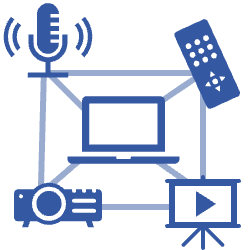What are educational technologies and how can I use them in my classroom?

This Expert Recommendation provides a quick overview of educational technology from the Faculty Teaching Institute. Educational technology is the use of computer software and hardware for learning purposes.
The Constellation of Educational Technologies
|
|
Educational technologies (in alphabetical order)
|
Audio or video, podcasts |
Short pieces of audio or video about a particular topic. The instructor could ask students to listen or watch as a homework assignment or show them in class. Students could be assigned to create a podcast or video. |
|
Blogs |
A regularly updated website or web page, usually written in an informal or conversational style. The instructor could ask students to write blog posts about their learning journey or a topic. |
|
Classroom response systems |
A system that can be used in a classroom to anonymously collect an answer to a question from every student. This allows rapid reliable feedback to both the instructor and the students plus individual accountability. Polling can be done through physical devices (clickers), colored cards, holding up fingers, or a web interface through students’ phones or laptops (e.g., PolleverywhereTM, SlidoTM). |
|
Collaborative writing |
Students co-create or contribute to a written document. For example, the instructor could write a question prompt or discussion topic in a document, and ask students to work together to write their ideas in response. In Google DocsTM, multiple students can add text, links, graphics, equations, and comments to a word-processed document, at the same time. With PadletTM, the instructor can create the layout for an online wall; students can respond by posting notes (with text and/or media) and “liking” others’ notes. |
|
Course management system (CMS) |
An online environment for course interactions such as posting material and submitting assignments. The CMS is usually provided or mandated by the university. Sometimes called a learning management system; LMS. |
|
Discussion platform |
Students discuss concepts or seek help in an online asynchronous forum. Many CMS have online forums, or consider PiazzaTM and SlackTM. |
|
|
Electronic mail. A convenient way for the instructor and students to correspond outside of class. The instructor can send class-wide email messages, and correspond with individual students. |
|
Listservs |
A platform for sending emails to a (large) group of people at the same time, often included in the CMS. |
|
Presentation software |
Software such as PowerpointTM, KeynoteTM or Google SlidesTM, that allows the instructor to display slides with text, equations, graphics, etc. |
|
Simulations or animations |
Computer-based depictions of a physical phenomenon. Sets of online simulations include PhET Interactive Simulations, Physlets, and Open Source Physics. |
|
Social annotation software |
Group-based commented reading of a text. Students use the software to take notes, and then the instructor and other students can read and reply to their notes and comments (e.g., Google DocsTM, PerusallTM). |
|
Web conferencing software |
A communications platform that allows groups of users to connect with video, audio, and chat over the internet. The instructor can hold full class sessions on ZoomTM or hold office hours, one-on-one conversations, etc. |
|
Websites |
Pages on the Internet. The instructor could ask students to read or find pages about a particular topic, then write reactions or answer questions about the topic. The instructor can also point to websites as resources for more information for students. |
|
Wiki |
A wiki is a collaborative website where multiple users can add and edit information on internal pages. An instructor could create a wiki for their course, where students and instructors can post resources or ideas. |
This Expert Recommendation is based in part on W. McKeachie & M. Svinicki, McKeachie’s Teaching Tips (Cengage Learning, 2014), and Clickers/personal response systems (University of British Colombia, Carl Wieman Science Education Initiative).
This material is based upon work supported by the National Science Foundation under grants DUE-2141678, 2141745, 2141769, 2141795, and 2142045. Any opinions, findings, and conclusions or recommendations expressed in this material are those of the author(s) and do not necessarily reflect the views of the National Science Foundation.
 Add a Comment
Add a Comment


